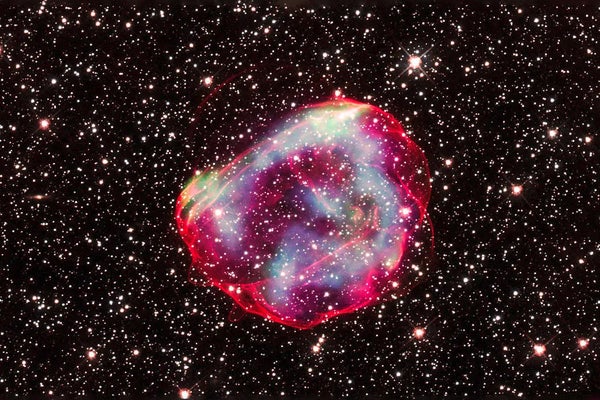Surprising Supernova Scars Cover the Earth
A supernova showering Earth with radioactive debris is a surprisingly common cosmic occurrence
By Phil Plait

A vast, expanding cloud of debris from a supernova, as seen in x-ray and optical light by the Chandra X-ray Observatory and the Hubble Space Telescope, respectively.
X-ray: NASA/CXC/GSFC/B. J. Williams et al.; Optical: NASA/ESA/STScI
I recently wrote about the dangers of a nearby supernova, a star exploding close to our own solar system. For astronomers, though, “close” means something different than it does for other people. In this case, a supernova within about 160 light-years, or 1.5 quadrillion kilometers, would qualify.
On a human scale, that’s a nearly unfathomable distance. On a galactic scale, it’s in our immediate neighborhood.
Still, it’s a long walk, and supernovas are fairly rare, occurring roughly once per century in a large galaxy like our Milky Way. So the odds are good that any given exploding star will be pretty far from Earth and will do nothing more than put on a pretty light show (if we can see it at all through the thick dust that shrouds parts of our galaxy).
On supporting science journalism
If you’re enjoying this article, consider supporting our award-winning journalism by subscribing. By purchasing a subscription you are helping to ensure the future of impactful stories about the discoveries and ideas shaping our world today.
But note my weasel words “any given exploding star.” The thing about relatively rare events is that, given enough time, they will happen. We again have to think on cosmic scales: Generously speaking, one supernova per century is maybe once per human lifetime. But galaxies (and Earth) have been around for billions of years. That’s more than long enough for the probability of a too-close-for-comfort supernova to become a certainty.
I personally wouldn’t bet against it. After all, we have convincing physical proof of this happening in our planet’s past.
In 2016 two teams of astronomers published a pair of papers in the journal Nature with startling results: they found elevated amounts of iron 60 in two different layers of ancient sediment from the deep seafloor. Each of those iron 60–enriched layers marks a time during the past nine million years when Earth was bombarded by a nearby supernova.
Iron 60 is a radioactive isotope of iron that decays into cobalt 60 with a half-life of 2.6 million years. This means that if you start with a pure sample of iron 60, in 2.6 million years, half of it will have decayed to cobalt 60. In another 2.6 million years, the remaining iron 60 in the original sample will have again decayed by half, leaving only one quarter of the starting amount of iron 60, and so on. Scientists can use this decay rate to get relatively accurate measurements of when the iron 60 was made.
That in turn is important because we only know of one natural place where this isotope can be forged: in the nuclear fires of a supernova.
In the first Nature paper, scientists examined interstellar dust that was deposited on the ocean floor and found two broad peaks in the amount of iron 60 in sediments that were deposited around 7.5 million and 2.5 million years ago. (In a separate 2016 study, another team of scientists also found iron 60 in fossil bacteria on the ocean floor that was consistent with the peak dating to circa 2.5 million years ago.) Curiously, in the Nature study, the increases in iron 60 weren’t sharp spikes, as you’d expect from a single supernova. Instead, in each case, the increases were spread out over more than a million years, implying that multiple supernovas contributed to each episode. The researchers’ models indicated the material spent about 200,000 years coasting through interstellar space before it fell to Earth.
In the second Nature paper, scientists who were affiliated with the first team used these data to estimate where in space the supernovas were located. Iron 60 is created when massive stars explode. Such stars give new meaning to “cradle to grave,” cosmically speaking, because they are born in giant gas clouds, only to die just a few million years later while they are still cocooned inside.
This second Nature study flagged the most likely culprit for both supernovas as the Scorpius-Centaurus association, a loosely bound clump of young stars that are presently located about 390 to 470 light-years from Earth. Many of these stars are quite massive and exactly the kind that explode at the end of their life. Moreover our sun sits near the middle of what’s called the Local Bubble, a huge cavity carved out of the interstellar material that floats between stars in the galaxy. The bubble was inflated by supernovas in the Scorpius-Centaurus association some 14 million years ago and probably required the work of 14 to 20 such exploding stars. This timeline fits well with the iron 60 peaks observed in ocean sediments.
The scientists found that two supernovas may have contributed to the most recent peak, with one exploding 2.3 million years ago and the other doing so 1.5 million years ago. Both stars would have been about 300 light-years from Earth when they exploded. The amount of iron 60 in the sediments is actually quite small, very roughly 100,000 atoms per gram of material. (Mind you, a gram of sediment has something like 1022 atoms in it, so the iron 60 makes up only an extremely tiny portion!) But the astonishing thing is thatdebris from exploding stars quadrillions of kilometers from us is there at all.
Bear in mind as well that iron 60 makes up a small fraction of the material ejected in a supernova. The rest of the ejected matter—more than 10 octillion metric tons of it, so a lot—is also accelerated outward at speeds of tens of millions of kilometers per hour. As matter expands away from the blast site, it thins out, so by the time the ejecta from a nearby supernova reaches Earth, perhaps a few hundred metric tons might rain upon our planet over a length of time. That might sound like a lot, but about that same amount of meteoric material slams into our atmosphere every day. So supernovas aren’t appreciably adding to Earth’s weight, nor are they a big danger to us in this way.
Still, the takeaway is stunning: Every few million years, a supernova happens close enough to Earth to shower us with radioactive debris. That means that, over the lifetime of our planet, we’ve been hit thousands of times with ashes from exploding stars, and some of that material has likely been close enough to cause some of the global damage I described in my previous article.
And in the specific case of the most recent known nearby supernova, while humans weren’t around back then, several of our near ancestors, such as Australopithecus afarensis, were. One particular member of that species, nicknamed Lucy, walked on Earth about three million years ago. She may have missed that particular event, but if so, her descendants may have gazed up into the sky and wondered about the astonishingly bright light that appeared there, brighter by far than any other star, as bright as the full moon. It would’ve been luminous enough to see by day and cast shadows at night.
And here we are, millions of years later, still wondering over the same thing. The difference is that now we have the tools to both examine and understand the profound impact these cosmic explosions have on our planet.
>>> Read full article>>>
Copyright for syndicated content belongs to the linked Source : Scientific American – https://www.scientificamerican.com/article/how-often-do-supernovas-strike-earth/






























